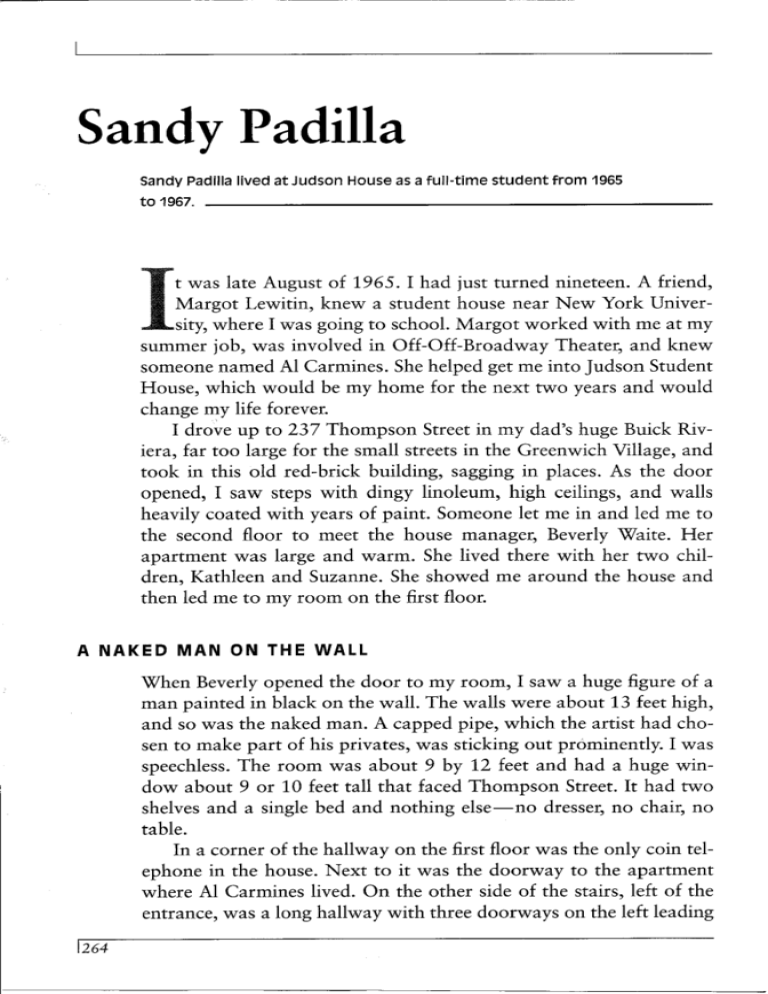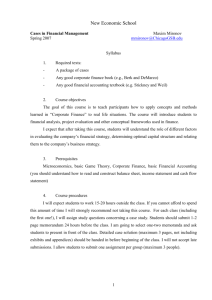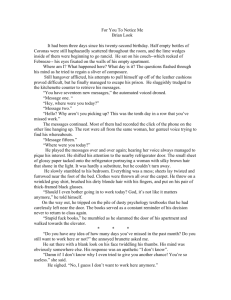Sandy Padilla - Judson Memorial Church
advertisement

Sandy Padilla Sandy Padilla lived at Judson House as a full-time student from 1965 to 1967. t was late August of 1965. I had just turned nineteen. A friend, Margot Lewitin, knew a student house near New York University, where I was going to school. Margot worked with me at my summer job, was involved in Off-Off-Broadway Theater, and knew someone named Al Carmines. She helped get me into Judson Student House, which would be my home for the next two years and would change my life forever. I dro~e up to 237 Thompson Street in my dad's huge Buick Riviera, far too large for the small streets in the Greenwich Village, and took in this old red-brick building, sagging in places. As the door opened, I saw steps with dingy linoleum, high ceilings, and walls heavily coated with years of paint. Someone let me in and led me to the second floor to meet the house manager, Beverly Waite. Her apartment was large and warm. She lived there with her two children, Kathleen and Suzanne. She showed me around the house and then led me to my room on the first floor. When Beverly opened the door to my room, I saw a huge figure of a man painted in black on the wall. The walls were about 13 feet high, and so was the naked man. A capped pipe, which the artist had chosen to make part of his privates, was sticking out prominently. I was speechless. The room was about 9 by 12 feet and had a huge window about 9 or 10 feet tall that faced Thompson Street. It had two shelves and a single bed and nothing else-no dresser, no chair, no table. In a corner of the hallway on the first floor was the only coin telephone in the house. Next to it was the doorway to the apartment where Al Carmines lived. On the other side of the stairs, left of the entrance, was a long hallway with three doorways on the left leading to the only three student rooms on the floor. The middle door led to my room. At the end was another apartment, which housed Ro Lee, the church secretary at the time. Down the right side of the hallway was a small bathroom with a shower for use by the three students. Two windows beyond the bathroom door faced out to the garden on the ground floor below. The bathroom was dark and dingy. I looked inside the shower and wondered how I would step into it every day. But it was home and I was always the optimist, so I knew I would be fine. I soon met Ro Lee, who lived with her black cat Mister. He roamed freely about the house and considered it his territory, often marking it by spraying freely. Next to me, on my right, lived Bena Shalit, a student. On my left lived another student, Lurline Purvis. The kitchen, which was in the basement, had four doors. The entry was on its north wall. The west door led to the back yard, a place that no one ever ventured into because of its delapidated condition. On the east wall a door led to Thompson Street. The door on the south wall near the corner led to Ed Brewer's apartment. Ed Brewer was the church music director with a fascination for harpsichords. In fact, he later built a harpsichord from a kit. The final product was spectacular, and he gave a concert on it at the church. The first year I lived at Judson, there was a meal plan and we had access to the food in the pantry and use of the large kitchen. The kitchen had several long tables and chairs, a large industrial stove, extra large refrigerator, huge sinks, and surface areas and large cookware. Next to the kitchen was the pantry. The shelves were filled with lots of large, institutional red-and-white cans of Sexton foods. The cans included tomato sauce, tuna fish, juice, and more. As residents we could cook food on the large stove. Of course, we were supposed to clean up afterward. That first year the kitchen was maintained by Willie Mae Wallace, a black woman who did not live in the house. She also cleaned Al Carmines's apartment. It was clear to everyone who was in charge of the kitchen, and she told us so regularly in her large, booming voice, complaining about the students and the conditions of the common areas we lounged in. On the other side of the stairwell in the basement was a door to the communal living room. This large room had a sofa and lots of chairs. There were small end tables at various places with table lamps on it. Next to the large sofa was a coffee table, and against the right-hand wall was an old upright piano. In the northwest corner of the room was a doorway that led through what we thought of as mysterious passages to the church. The first thing I did was paint my room and get a 9 by 12 carpet to cover the floor. I didn't know anything about primer, and each time I painted over the large black figure, he would start seeping through the layers of paint again after a few months. Eventually I was able to cover it up. I met others in the house, including Jon Hendricks. He was a conscientious objector who had been assigned to work at Judson Church in those years of the Vietnam War. I also met Christopher Holt. Chi'is (or Eugene, as his mother called him when she telephoned and asked for him) was studying flute at the Manhattan School of Music. Chris and I became close friends. We decided to work on the Mozart flute sonatas and spent hours practicing. Later, Chris and I played at the wedding of Larry Kornfeld and Margaret Zipse at the house. As I talked to other students, I learned they studied everywhere: Cooper Union, Bank Street School of Education, the New School of Social Research, Pratt Institute, and Fashion Institute of Technology. I believe I was the only one studying at NYU that year. Over the next two years, I would become friends with other students: Carole Petersen, Tom Roderick, Lurline Purvis, Ann Weingarten, Hank Darrah, John Anderson, a girl named Sam, and many others. In the summer we had students from medical schools stay at the house. Their idea of partying was to bring in pure alcohol and mix it with the Sexton cans of juice. Carole Petersen and I couldn't stand our bathroom, and we persuaded Beverly to provide us with paint and supplies to fix it up. She gave us money to buy mosaic tile and floor covering, and Carole and I went to Pintchiks supply store and bought yellow paint and yellow-and-white mosaic tile. After a few weeks we completed the bathroom and finished it off with curtains. Living on the first floor, a few feet from the entrance, I heard people coming in and out of the house. I soon met Al Carmines, who initially held no interest for me. I always heard his booming yoice and the slam of his apartment door. Every once in a while, he ,Yould come down to the kitchen and spend time with some of the people. He was larger than life, warm and friendly, and he always walked quickly. He had a huge laugh. Sometimes a tiny bit of a Southern drawl would come out. People in the kitchen told me he was a composer and did shows that played at the church. How curious, I thought, shows at a church -nothing like the churches I had attended. One day, I was playing classical music on the piano in the living room and Al came downstairs to hear who was playing. He was surprised and learned that I had studied piano at the Juilliard Prep Division. We 'talked briefly and I stopped playing. I preferred to play when alone and I didn't care for an audience. That fall, I went to see a play at the church. It was OK, but I fell in love with the music Al had composed for it. The name of the play escapes me, but I found myself going over to the church just about the time the songs I liked started and then I would leave. That was my first exposure to the Judson Poets Theater. One day Al asked me if I would be in a show he was directing. I said no. He was surprised that I wasn't interested. Over the next weeks, I heard people going in an out of his apartment to audition. I certainly was not going to be one of them. Chris came to talk to me about this show Al was doing and that Al wanted me in it. I still said no. I wanted to be left alone. Chris persisted, and so did AI. I learned that Al had written the music for plays such as Home Movies, for which he won the Obie award in 1963, and for a play by Maria Irene Fornes, which was being performed just as I came to the Judson. Al told me the new show was called Pomegrenada, by Harry Koutoukas, and he wanted me to be a singing flower. It sounded absolutely absurd. I finally figured, oh well, no one I know will see me, and after much effort on their part I finally relented. It was the winter of 1966. We had the initial smaller rehearsals in AI's apartment at the Student House. There, Al would meet with Julie Kurnitz, Meredith Monk, and me. Other times, we would walk over to the church for larger rehearsals. I met other members of the cast, including Margaret Wright and David Vaughan. Al directed the show. The set was a fantasy with makeup by Remy Charlip and lighting by Johnny Dodd. Harry Koutoukas would swirl into Judson House to visit Al in his black cape and leave a lasting impression of his artistry wherever he went. The show opened in March 1966 to great reviews in the Village Voice. Edith Oliver also reviewed it in the New Yorker. We "flowers" received favorable reviews as well. I was hooked! We would often have rehearsals Saturday mornings. Since I stayed up all hours on Friday nights, Al would come and wake me. He would stand in the doorway of my room singing: "It's morning now, the sun is up, the moon is down, its really morning now!" These were the first lines of the flower song in Pomegranada and the first lines for the opening scene of the show. He would boom, "time to get up darling," and he would not leave until he was sure I was getting up. Lee Guilliatt was stage manager for one of the shows. I was amazed at her capacity for building sets. Lee became a mainstay at the theater, and over the years she moved from stage manager to star performer. She had a unique voice and on occasion would pull out her guitar and sing ballads. Some she wrote herself, and each was unique because of the quality of her voice. I asked Lee if she could build cabinets for my room at Judson, since I lacked storage space and I wanted things to be organized. She built me two large bookcases, which I stained and used to store my books and stereo on the top shelves and sweaters and other clothing on the lower shelves. My room at Judson House was the only one with wall-to-wall carpeting, custom bookcases, and curtains. I also had the only television. On weekends and late evenings, students would hang out in my room into the wee hours of the morning. Carole Petersen loved to watch the Johnny Carson show. Often, I fell asleep and they just stayed and chatted and hung out. In my next year, the plays continued and I would hear music and singing flowing out of AI's apartment as he created songs and rehearsed with cast members for new productions. One of my favor- ites was his creation of In Circles, a play in which he put Gertrude Stein's words to music. A huge success, it won many awards, including another Obie and the Vernon Rice Award. The director for this was Larry Kornfeld. On opening nights of shows or during the holidays, Al often had parties at his place. The apartment was crowded with people who flocked to him because of his immense charisma. During opening nights, the parties didn't begin until 11 p.m. The overflow generally streamed into the house entryway and sometimes down to the kitchen and living room. Booze flowed freely and people got incredibly drunk. AI's favorite was gin. The moment many waited for usually came about 1 a.m., when Al would slip onto the piano bench and start singing the blues. Everyone's favorite was "Beale Street Blues." People lived for this moment. Also during my second year in the house, I bought a Lambretta scooter, which I kept in back of Judson House. I remember an incident involving that scooter. As I was coming around the corner of Washington Square South onto Thompson Street, Jimmy Waring stepped into the street without looking. I turned wide to avoid him and my scooter went over. I hit my head on the street. I also hit Jimmy Waring's pinky finger, and he went back into the church and passed out from fear. Jimmy Waring was a dancer and choreographer well known in the avant-garde dancing world. It turned out I had a concussion and was sent back to my room to rest. When I laid on my bed, the ceiling above the bed collapsed and pounds of heavy plaster (not plaster board!) fell directly on my head. Plaster dust filled the rooms and hallway. Students came from throughout the house to see what the huge bang had been. No one was seriously hurt, but it was a memorable event to laugh about for years. The Student House also had its share of artists. The Judson Gallery was part of the house. You could get to the gallery through the living room in the basement level. I remember the gallery getting a lot of publicity during the "Happenings" that took place there in 1967 and 1968. I was involved with one artist couple. Their names were Anthony Cox and Yoko Ono, and their little girl was Kyoko. She was three or four at the time. Kyoko would often be barefoot and wander around as children do at that age. I asked Yoko if I could take Kyoko to my room where I could watch her and where I had a wall-to-wall carpet. Often, when I came back from school I would pick up Kyoko and she would stay in my room. The kitchen was a community place for many of us to hang out at and laugh for hours. Julie Kurnitz would come often at night and sometimes bring her guitar. Several of us including Al would sit around the table. We had a great and sometimes raucous time as Julie and AI, with their incredible wit, would pepper the conversation with humor and dishing. Jack Matlaga came in 1966 to be resident manager for the students. He was also a minister. He lived on the third floor in one of the smaller rooms. He had a love of Greece and had traveled there and seemed to know everything about Greek culture and food. Jack was delightful and he soon became fast friends with Julie Kurnitz. The kitchen table got larger with fun, talk, and entertainment. Reathel Bean came to live in the house as a CO. He, too, joined the circle of friends and became a part of the theater. The summer I turned twenty-one, 1967, was the last time I lived at Judson. However, it was just the beginning of what would be years of activity with the church and the theater. Over the next ten years, there would be many visits to Judson House and Ai's apartment. The garden behind the house was fixed up and eventually we even had garden shows there. We also had the famous Judson street bazaars as fundraisers, which were always considered great events. In 1977 I left New York City, and my association with Judson faded. My friendship with Al never did, and twenty-eight years after I met him, he was the minister who performed the service at my wedding. He also performed for the guests, many of whom had seen his shows over the years. It made the day extra special and filled it with wonderful memories. Judson House will influence my life forever. I met extraordinary people through Judson Memorial Church and the Judson Poets Theater, its two forward-thinking ministers, and its small dynamic com- munity. My life has been richer and happier because of the day I walked up to that sagging old building when I was nineteen years old. SANDY PADILLA lives near Albany, New York.






